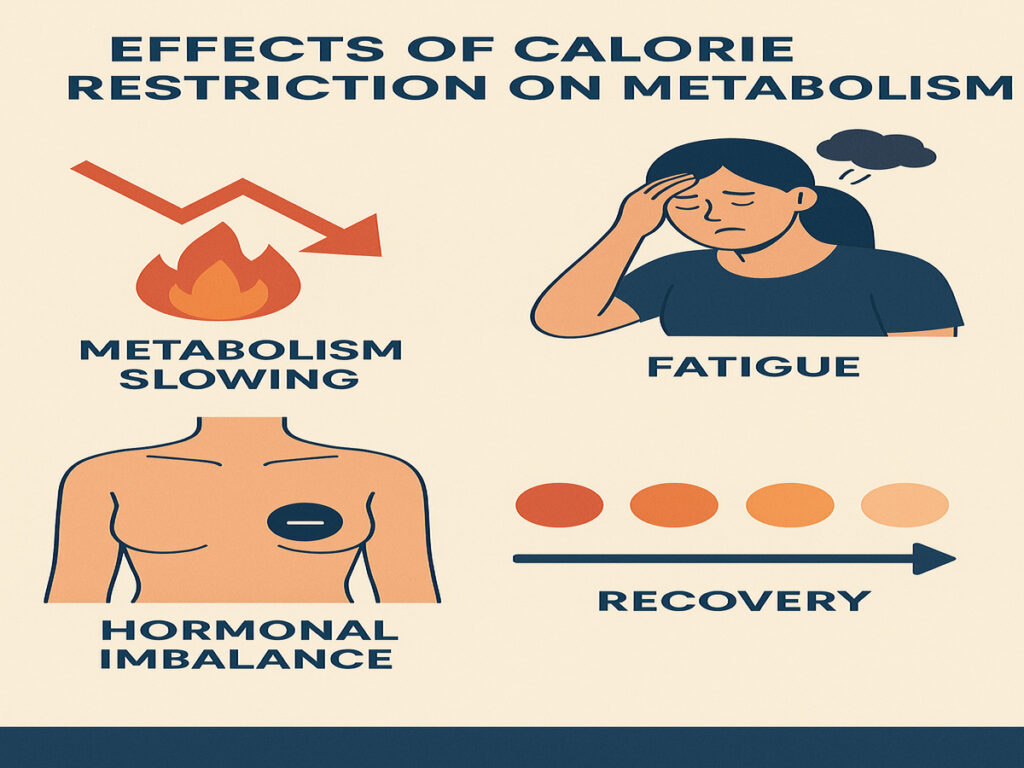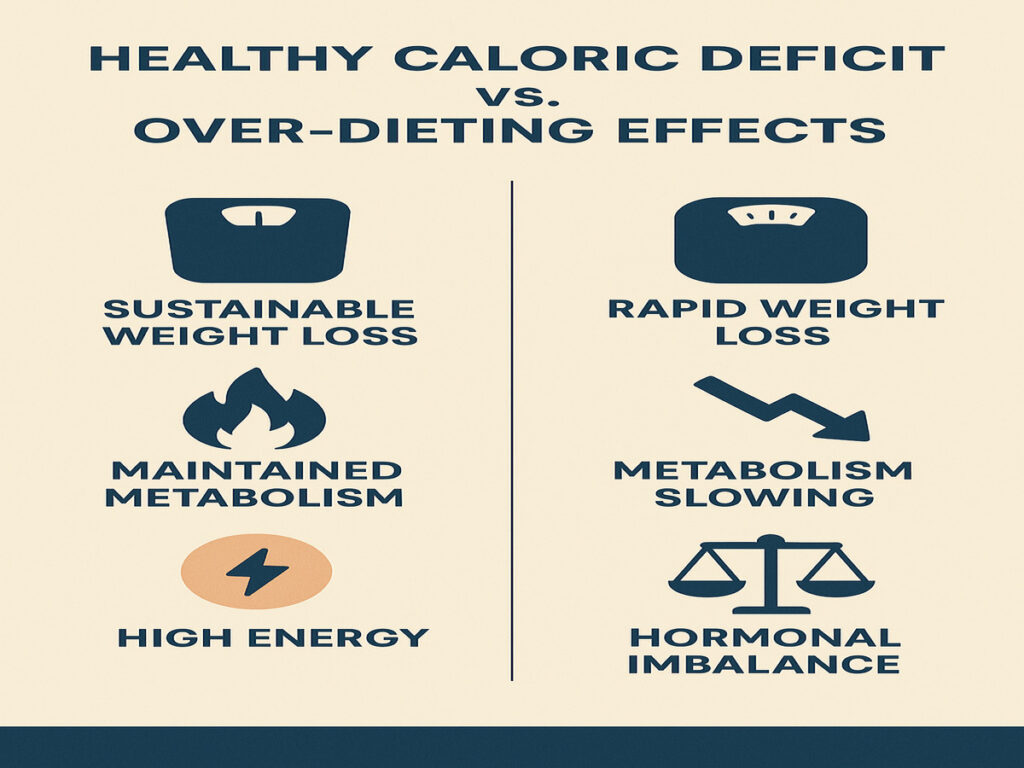Introduction: What Is Metabolic Damage Recovery?
Metabolic damage recovery refers to the process of restoring your body’s natural metabolic function after prolonged calorie restriction, crash diets, or excessive exercise. When Americans push their bodies too hard in pursuit of rapid weight loss, the metabolism often adapts by slowing down—burning fewer calories and increasing fatigue, hunger, and hormonal imbalances.
This recovery process focuses on repairing energy balance, resetting hormones, and rebuilding muscle tissue to restore optimal metabolic health.
Statistic: According to a 2024 Journal of Metabolism report, nearly 68% of Americans who follow aggressive diets experience some form of metabolic slowdown within six months.

The Science Behind Metabolic Adaptation
Your metabolism isn’t static—it constantly adjusts to energy intake and expenditure. When you diet too aggressively or for too long, your body enters adaptive thermogenesis, reducing its calorie burn to preserve energy.
Key physiological responses include:
- Reduced thyroid hormone (T3) levels → slower metabolism
- Lower leptin → increased hunger and reduced satiety
- Higher cortisol → increased stress and muscle loss
- Reduced resting metabolic rate (RMR)
This adaptation is a survival mechanism, not a malfunction. However, without recovery, your energy, hormonal balance, and body composition may continue to deteriorate.
Signs and Symptoms of Metabolic Damage
If you’ve been dieting hard but no longer see results—or even gain weight despite eating very little—your body may be in a metabolically suppressed state.
Common symptoms include:
- Persistent fatigue and brain fog
- Cold intolerance and low body temperature
- Constant hunger or complete loss of appetite
- Sleep disturbances
- Hormonal irregularities (especially in women)
- Plateaued fat loss despite calorie restriction
- Muscle loss and reduced performance
Expert insight:
“Metabolic damage is the body’s SOS signal. It’s not broken—it’s trying to protect itself. The key is strategic recovery, not more restriction.”
— Dr. Megan Rios, PhD, Metabolic Health Researcher, Stanford University
The Hidden Cost of Over-Dieting
Dieting too hard can backfire in ways that extend beyond temporary fatigue or weight fluctuations. Chronic caloric restriction can lead to:
| Effect | Description |
|---|---|
| Hormonal Disruption | Lower leptin, thyroid, and sex hormones. |
| Muscle Catabolism | Muscle loss decreases resting metabolism. |
| Digestive Dysfunction | Reduced gut motility, bloating, and poor nutrient absorption. |
| Psychological Stress | Heightened anxiety and food obsession. |

How Metabolic Recovery Works
The goal of recovery is to restore the body’s energy balance and hormonal homeostasis through a gradual and controlled process known as reverse dieting or metabolic rehabilitation.
1. Gradual Caloric Restoration
Slowly increasing calorie intake (5–10% every 1–2 weeks) helps the body adapt upward without excessive fat gain.
2. Macronutrient Optimization
Rebalance carbs, fats, and protein to repair metabolism:
- Protein (1.2–1.6 g/lb) to preserve lean mass.
- Complex carbs to restore thyroid and leptin levels.
- Healthy fats to regulate hormones.
3. Strength Training
Building lean muscle increases your resting metabolic rate. Resistance training is a non-negotiable part of recovery.
4. Stress Management
Chronic dieting elevates cortisol, which slows recovery. Incorporate yoga, mindfulness, or low-intensity movement.
5. Sleep Regulation
Aim for 7–9 hours per night. Sleep deprivation suppresses metabolism and insulin sensitivity.
Actionable Recovery Strategies
- Track baseline intake before increasing calories.
- Add calories gradually — focus on nutrient-dense whole foods.
- Include refeed meals weekly to boost leptin and glycogen stores.
- Prioritize resistance training over cardio during recovery.
- Hydrate adequately to optimize digestion and thermogenesis.
- Use NEAT (non-exercise activity thermogenesis) — light walking, chores, etc.
- Avoid crash diets or fast reversals — slow, steady progress wins.
Practical Checklist for Metabolic Repair
☑ Increase calories by 5–10% every 1–2 weeks
☑ Train with resistance 3–4 times per week
☑ Get 7–9 hours of quality sleep
☑ Consume 1.2–1.6g protein per lb body weight
☑ Prioritize hydration (2.5–3L daily)
☑ Limit cardio to low intensity
☑ Manage stress through mindfulness
Nutrient-Dense Foods Table
| Food | Key Nutrients | Metabolic Benefit |
|---|---|---|
| Salmon | Omega-3s, Protein | Supports hormone balance |
| Sweet Potatoes | Complex Carbs | Restores glycogen, boosts energy |
| Greek Yogurt | Probiotics, Protein | Gut support and muscle recovery |
| Eggs | Healthy fats, Choline | Hormonal and brain health |
| Quinoa | Amino acids, Fiber | Sustained energy and digestion |
| Spinach | Magnesium, Iron | Reduces fatigue and stress |
| Almonds | Vitamin E, Healthy fats | Supports cell recovery |

Expert Insights on Metabolic Repair
“The most successful metabolic recovery plans prioritize nourishment and strength, not punishment or deprivation.”
— Dr. Lauren Pierce, Functional Nutritionist
“You can’t outsmart physiology. Repairing metabolism takes time, but your body rewards consistency with resilience.”
— Dr. Ben Hartley, Exercise Physiologist
Common Myths & FAQ
Q1: Is metabolic damage permanent?
A: No. With proper nutrition and recovery, most people fully restore metabolic health in 8–16 weeks.
Q2: Should I eat at maintenance right away?
A: Not necessarily. Gradual calorie increases prevent rapid fat gain.
Q3: Can cardio help with recovery?
A: Light movement supports circulation and mood, but overdoing cardio delays recovery.
Q4: How do I know when I’ve recovered?
A: Indicators include better energy, stable hunger, improved sleep, and restored menstrual or testosterone levels.
Authoritative Resources
- National Institutes of Health – Metabolism Overview
- Harvard Health – Metabolism and Weight Loss Science
- American College of Sports Medicine – Nutrition for Recovery
Other important Articles
- The Cortisol Reset Blueprint: Managing Stress Hormones Naturally
- Microdosing Fitness: Small Workouts, Big Gains in 2025
Conclusion & Call-to-Action
Metabolic damage recovery isn’t about eating more junk or abandoning structure—it’s about rebuilding trust with your body.
By eating more strategically, lifting smarter, and prioritizing rest, your metabolism can return stronger than before.
Next Step: Start tracking your current intake, add 100–150 calories weekly, and focus on nutrient-dense, high-protein meals. Within weeks, you’ll notice improved energy, better workouts, and restored metabolic function.

